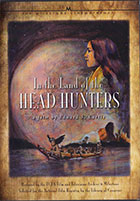
In the Land of the Head Hunters 1914; Restored in 2014
Distributed by Milestone Films & Video, PO Box 128, Harrington Park, NJ 07640-0128; 800-603-1104
Produced by MILESTONE Film & Video; Restored by the UCLA Film and Television Archive & Milestone
Directed by Edward S. Curtis
DVD , Black & White with Color Tinting, 66 min.
Sr. High - General Adult
Anthropology, Culture, Indigenous Peoples, Multiculturalism, Native Americans, Native Peoples, Photography
Date Entered: 02/26/2015
Reviewed by Jennifer Loft, Ph.D. student in Global Gender Studies, Department of Transnational Studies, University at BuffaloFor quite some time, anthropologists and so-called “preservationists” have been recording the cultural traditions of Indigenous peoples in North America in the hopes of “saving” these cultures from extinction when the Indigenous populations inevitably “died out.” The director of In the Land of the Head Hunters, Edward S. Curtis, was one such preservationist who is best known for his iconic photographs of Indigenous peoples, particularly in the American West. This restored version of the 1914 silent film era classic features Kwakiutl, ‘Nak’waxda’xw, and other Kwak’wala-speaking people of Canada’s Pacific coast, who still maintain residence in British Columbia to this day.
As a silent film, In the Land of the Head Hunters extensively chronicles the cultural traditions – especially dances – of the aforementioned Indigenous community in this “drama of primitive life.” While the viewer can physically watch some of the dances and traditions that are integral to this Indigenous community, zero context is given to any of the recorded cultural traditions. Because of this, it is difficult for this reviewer to discern the implications – whether intended or not – to the general public watching this film if they lack any context of Pacific Northwest Indigenous societies. The regalia worn, dances performed, and violence enacted throughout the film lead to a rather “savage” depiction of this Indigenous community. It is crucial to remember that these Indigenous communities have cultural traditions that are simply different from our Western notions of tradition, which does not necessarily mean that the traditions depicted in this film are “primitive” or “uncivilized.” While this reviewer is concerned about the ideas the general public may harbor about this Indigenous population after viewing the film, In the Land of the Head Hunters does have some technical merit. The restoration of this film means that one of the first films produced in North America – and perhaps one of the first that stars real Indigenous peoples – during the silent film era is available for film scholars, students, and enthusiasts. Many of the moving picture scenes were restored with color tinting, and the remaining scenes that could not be restored were replaced with still shots. This film has excellent educational potential for those in film and media study – although it is absolutely crucial that the implications of so-called “primitive” depictions of Indigenous peoples also be addressed.
A true classic and treasure of the silent film era, In the Land of the Head Hunters is a film that should not be consumed for pure entertainment; instead, viewers should be ready to critically engage with its technical merits and the decontextualized images presented. I would recommend this film, with reservations, to those determined to embark on a visual journey that may raise more questions than can be answered. While a gem for the time period it was originally produced in, it is definitely time to let Indigenous peoples tell their stories and share their cultures in the manner they deem most conducive to educating the general public.